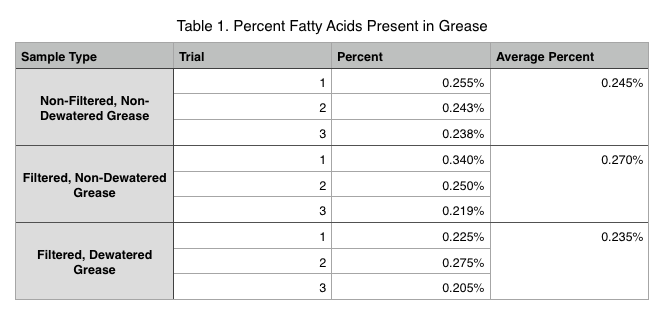The washing process was over once all of the water turned out clear. At this point, the biofuel needed to be dried to remove any excess water in the biofuel. In order to dry the biofuel, it was heated to just below the boiling point of water. Once this process was completed, we had our first batch of biofuel!! Figure 1 shows the unfiltered, undewatered biofuel, figure 2 shows the filtered, undewatered biofuel, and finally figure 3 shows the filtered dewatered biofuel.
Figure 1. Unfiltered, undewatered biofuel.
Figure 2. Filtered, dewatered biofuel.
Figure 3. Filtered, dewatered biofuel.
Now that we finally produced biofuel (or so we think), it was time to test the efficiency to see if we really did make biofuel. In order to do this, we used three tests: a density test, and the 3-27 test (explained below). After talking to our graduate fellow, Megan, it was decided that the density of the biofuel should be around 0.88g/mL. Fortunately, all of the samples except Filtered Undewatered B were close to this value. This was most likely because the filter was used with water beforehand, so this sample contained a lot of water. The values of the mass, volume, and density of each sample is illustrated in figure 4.
Figure 4. Table of measured mass, volume, and density.
After the density test, the group performed the 3-27 test. This was a visual quality test. 27mL of methanol was added to 3mL of biofuel and it was shaken vigorously for thirty seconds. After allowing it to settle for five minutes, the solution was observed. If the solution was cloudy, the reaction was not complete and the biofuel was not a good quality. On the other hand, if the solution was clear, the biofuel was successfully made. After this test, the there were only two biofuels that were clear: unfiltered undewatered A and filtered dewatered B. The other three biofuels did not completely react. The solutions after this test are shown in figures 5, 6, and 7. This shows that the filtering and dewatering process effectively worked when creating the biofuel. Once again, the two samples that were filtered but not dewatered were of poor quality.
Figure 5. Quality test of unfiltered undewatered (B is left, A is right). Only A passed the test.
Figure 6. Quality test of filtered undewatered (A is left, B is right). Both samples failed the test.
Figure 7. Quality test of filtered dewatered (A is left, B is right). Only B passed the test.
After the tests, we wanted to see how our biofuel burned, so we selected our best sample (Filtered dewatered B) and burned it next to a sample of soybean oil. It was observed that the biofuel produced a larger flame than the soybean oil. The flames are illustrated in figure 8. However, the biofuel also produced more black smoke, but this is typical of diesel. In the end, this project was very successful and we learned a lot about the biodiesel process.
Figure 8. Flames of canola oil (left) and biofuel (right).






























.jpg)
.jpg)
.jpg)
.jpg)
.jpg)
.jpg)
.jpg)
.jpg)
.jpg)
.jpg)